Herbicide Advisor
General System description
System name: Herbicide Advisor
Acronym: n/a
Brief overview
Briefly define purpose & capabilities of the system and available components (if any) Should be a 1-2 sentence summary of system
Contents
Scope of the system
- tool encourages decision maker to discover new problems or opportunities by exposing to new information or results
- tool helps decision makers in recognizing upcoming problems for which solutions have been developed previously
- tool allows decision maker to actively create new knowledge when faced with a new problem and to develop novel solutions
- tool allows decision maker to capture knowledge, making it available to decision makers who are seeking solutions from previously solved problems
System origin
- Who and when was it developed
- how was it developed
- is it a commercial product
- does it have real-life application cases
Support for specific issues
Is the system designed to take into account specific uses? E.g. guidance on ways to characterize biodiversity, economic-biodiversity tradeoff analysis methods, risk assessment methods, landscape analysis methods, timber harvest effects, climate change effects, biological effects (pests, pathogens, invasives), fire,...
Support for specific thematic areas of a problem type
- Silvicultural
- Certification
- Conservation
- Restoration
- Transportation
- Development choices / land use zoning
- Policy/intervention alternatives
- Sustainability impact assessment (SIA)
Capability to support decision making phases
(NOTE I do not quite know what to do with this, as I do not understand it myself, although it seems related to system use)
(Click here to see a more detailed explanation)
- Intelligence (+ explicit description of the support given by the DSS)
- Design (+ explicit description of the support given by the DSS)
- Choice (+ explicit description of the support given by the DSS)
- Monitor (+ explicit description of the support given by the DSS)
Related systems
Describe (and/or link to) other systems related
Data and data models
Typical spatial extent of application
Typically applicable to stand level, and is aspatial. However it can be used to assess strategic implications associated with the withdrawal of a herbicide (eg what chemical alternatives will remain)
Forest data input
Describe the basic forest input (forest level, stand level, or individual tree level), and appropriate meta-data, such as data provenance (Areal coverage, Sample of plots, stands, Contiguous forest cover). GIS information is to be considered here, namely include cover tyes and type of information (raster or vectorial, necessity of topological information) If necessary describe surrogate sources of information
If necessary describe other types of required data (economic, social)
Type of information input from user (via GUI)
User enters one or more target weed species and optionally any tree species that are already planted on the site.
Models
Forest models
Growth, Yield, Carbon, Wood quality, biodiversity and habitat suitability, environmental and external effects (fire, storms, pests, diseases, climate change, etc)
Social models
n/a
Decision Support
Definition of management interventions
Define what is available for the manager to intervene in the forest: time of harvest, plantations, thinnings, reconversions... Existence of prescription writer, simple enumeration of all possibilities, scenario simulation , etc.
Typical temporal scale of application
Define the temporal scale of the application: E.g., operational and immediate level, Tactical planning (short term) and strategic level.
Types of decisions supported
- Management level
- strategic decisions
- administrative decisions
- operating control decisions
- Management function
- planning decisions
- organizing decisions
- command decisions
- control decisions
- coordination decisions
- decision making situation
- unilateral
- collegial
- Bargaining / participative decision making
Decision-making processes and models
- Logic modeling
- Operations research modeling
- Direct approaches
- Heuristic manipulation of simulation models
- Business modeling
- Simulation (with and without stochasticity)
- Multiple criteria/ranking
- Other
Output
Types of outputs
Tables of key information.
Spatial analysis capabilities
The herbicide advisor is an aspatial tool.
Abilities to address interdisciplinary, multi-scaled, and political issues
Implemented as a tactical stand level planning tool.
System
System requirements
- Operating Systems: Web based tool - server Java code will run on any operating system supporting a JRE 1.4.2+(Windows, Macintosh, Linux/UNIX)
- Other software needed (relational database eg Oracle), part of the stand level GB Forestry DSS portal
- Development status : released
Architecture and major DSS components
Web based tool, user specifies target weed species and optionally any tree species present on the site. The system responds with a list of suitable herbicides along with supporting information on timing of applications, effectiveness, constraints (eg farm forestry only) and the impact on any tree species present on the site.
Usage
Some use in research, forestry industries and education sectors.
Computational limitations
Describe the system limitations: e.g. number of management units, number of vehicles, time horizon
User interface
Describe the quality of user interface and the Prerequisite knowledge for using the system
Documentation and support
Describe the connection to Help-system and possibilities for assistance, as well as the required training and user support levels
Installation
- Prerequisite knowledge: Knowledge of vegetation, chemical safety (COSHH)
- Cost: free
References
Cited references
